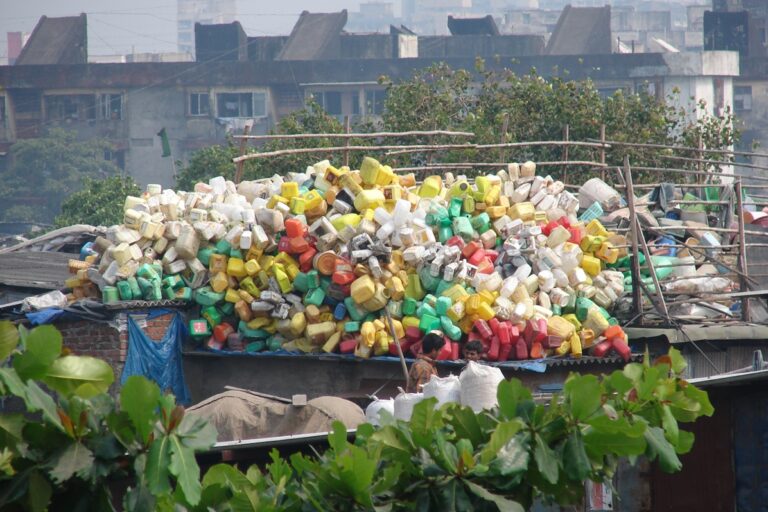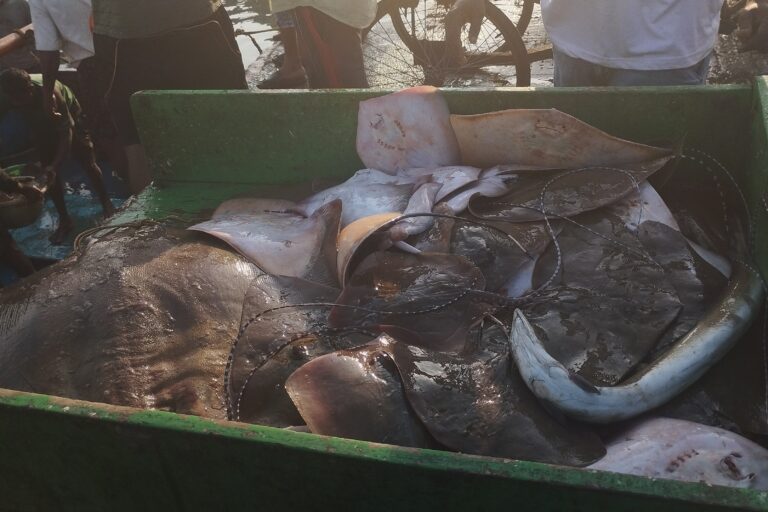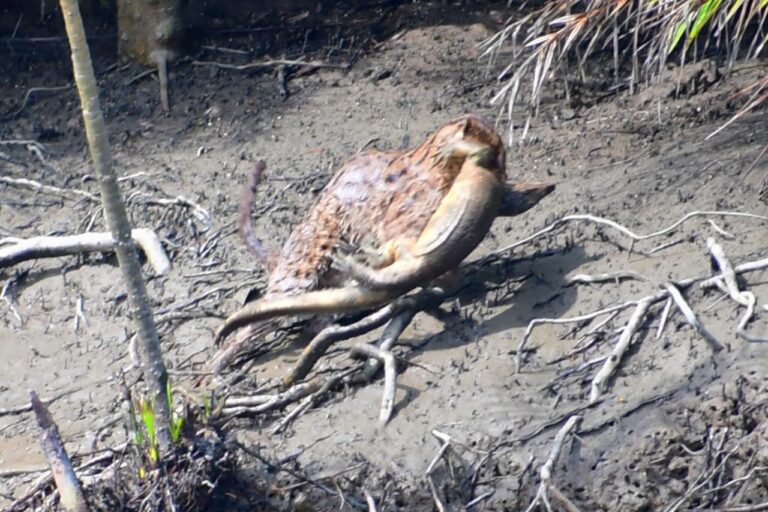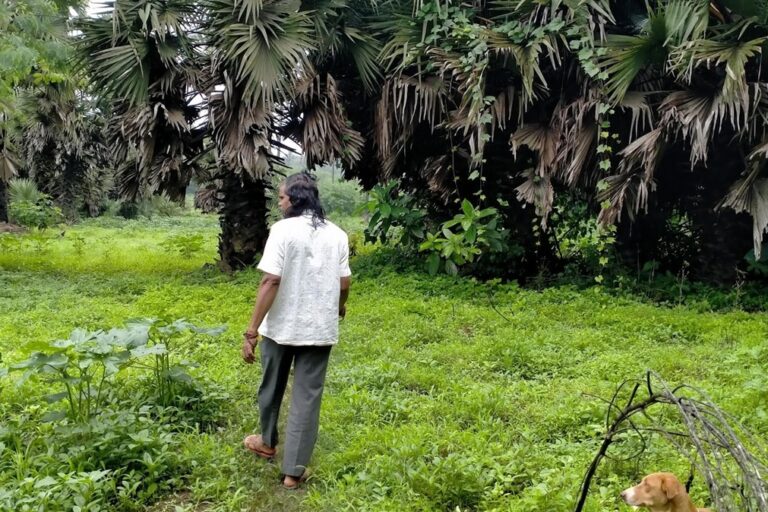- In Himachal Pradesh’s Majra village, animals and people are falling sick. The locals allege it is due to contamination of groundwater by a waste treatment plant.
- Chemicals leaking from a solid waste management plant in Majra are allegedly the reason behind the contamination. Officials at the plant, however, deny any such leakage.
- Experts also highlight that rivers in Himachal Pradesh are highly polluted due to waste dumping.
Around 20 years ago, Karmo Devi, a resident of Majra village in Himachal Pradesh’s largest industrial area, Nalagarh, dug a well for drinking water. For 20 consecutive years, she and her family have been drinking water from the well. But recently, after one of her milch (milk-producing) animals died, she suspects that the water of the well has been contaminated. “The colour of water has turned black. Due to this poisonous water, many cattle have died and even the villagers have fallen victim to many serious diseases,” she says, blaming the Shivalik Solid Waste Management Plant (SSWMP) for contaminating the water.
The SSWMP was set up in Majra around 15 years ago for treating the solid waste coming from various industries of the state. Balvinder Kaur, head of the village, said that a no-objection certificate (NOC) was obtained from the panchayat (local administration) by informing them that it was an environmental project, but later the panchayat found out that they were misled.
“Only after the plant was built, we came to know that hazardous chemical solid toxic waste of the different factories of Himachal Pradesh was to be brought to this plant which was responsible for treating this solid waste. When the cattle suspiciously started dying and villagers fell ill of various diseases, we realised that the waste management plant had contaminated the groundwater by dumping the waste into the ground instead of treating it,” said Balvinder Kaur.

In July 2021, the people of Majra wrote a letter to various authorities in the state in which they alleged that for the last 15 years the plant was dumping the solid waste in the ground, without proper treatment and covering it with soil. They alleged that over a period of time, the water of natural sources, wells and borewells of village Majra and the surrounding villages have become poisonous due to seepage of chemically contaminated water of this plant into the ground.
Sanjeev Kaushal, vice president of Him Parivesh, an organisation working for groundwater security in the area, visited the plant after villagers complained. He said that the polluted water is collected in the open, inside the plant premises from where it comes out of the rain drainage system into the village. He added, “During the rains, the chemicals also mix with the rainwater and go into the drains. The solid waste was lying around openly in the plant. From the vehicles which carry the waste chemical to the plant, the chemical was seen leaking.”
Gurdayal Singh, a resident of the village, who had worked in the plant for five years, said, “The plant is not treating its waste well. The plant has been built nicely but to save money, they are now playing with the life of people.”
“The solid waste is not treated properly inside the plant due to which these chemicals have completely entered the groundwater. The people are getting ill. Balvinder Singh, who used to work with me in the plant, is now suffering from various diseases due to working in the plant and drinking village water,” he said.
However, Ashok Sharma, who is the chief executive officer of the SSWMP, denied any water leakage from his plant. He said, “Not even one percent of chemical water inside his plant goes to the village. The waste and the water has been treated properly. The water in the village has not deteriorated because of the plant.”
Read more: Groundwater depletion in Haryana a cause of serious concern
Groundwater contamination
In the past decade, the Himachal Pradesh government has been proactively approving the industries in the state. To provide infrastructure support to entrepreneurs, Himachal Pradesh government has developed 41 industrial areas and 15 industrial estates. Solan, Sirmour, Kangra and Una districts lead in terms of investments attracted.
According to Economic Survey 2019-20, there are 54,310 units working in the state. Out of these, 140 industrial units are large and 628 are medium scale industrial units. The Solan district is considered the most developed district of the state from the point of view of setting up industries. There are 15 industrial parks in Solan including 5,331 small scale industries, 240 medium scale and 106 large scale industries.
Manshi Asher, the co-founder of Himdhara Collective, said, “Not only have these industries changed the land use of the state by cutting forests and polluting the air, but the solid waste from these industries are also polluting the groundwater and rivers. The state has been approving the industries at a rapid pace but the solid waste management issues are still a big problem for the state.”
Members of Himdhara shared the data collected from the Pollution Control Board which shows that more than 50 percent of the 2,063 units are operating without valid consent in the Baddi Barotiwala Nalagarh area. It shows that rarely show-cause notices are issued to units and, in cases, where these are issued, there is no follow up by the Board.
Himdhara said about 60 percent of the units do not have Effluent Treatment Plant (ETP) in the area and groundwater is severely polluted. A study by Panjab University assessed the groundwater in the area and revealed that levels of iron, lead, copper, manganese, and alkalinity had crossed desirable limits, and in some cases, even permissible limits.

Another study in Baddi Nalagarh industrial area found the presence of heavy metals in the groundwater. The study said that the heavy metals exceeded the prescribed limits at three sample sites: Baddi, Sandholi and Nalagarh. Manganese and iron were highest at Sandholi, Arsenic exceeded the limit in Nalagarh.
Yogesh Kumar Walia, Assistant Professor, Career Point University in Himachal Pradesh, said, “A large-scale industrial growth has caused serious concern regarding the health of groundwater in industrial areas of Himachal Pradesh like Solan, Baddi, Sirmaur and Nalagarh. Waste materials near the factories are reacting with percolating rainwater and reaching the aquifer system and hence degrade the groundwater quality.”
Asher emphasised that there is complete silence when it comes to solid waste management (SWM) in the state. “To overcome the issue, the state authorities promise to facilitate an integrated solid waste management system by creating efficient waste segregation, collection, transportation, processing and disposal mechanism on paper. But when it comes to the ground, there is a complete failure of policy and law. The case of the SSWMP or CETP confirms that. The state government is also not very active to solve these issues,” added Manashi Asher.
Rivers are turning into dumping grounds
According to experts, the rivers of the area are also now polluted because of the dumping of solid waste in the rivers. Earlier this year, water in Malpur khud in the Baddi industrial area turned blue after a tanker dumped untreated toxic industrial effluents from a pharmaceutical unit.
In 2018, the Central Pollution Control Board assessed 351 river stretches and, of that, seven were in Himachal Pradesh, they found that a stretch between Nalagarh and Solan was the most polluted river stretch in the state. They found that the rivers Beas, Sukhana, Markanda, Sirsa, Ashwani, Giri and Pabbar were highly polluted.
To ensure that the waste is treated properly, the state government has set up plants like the SSWMP and a Common Effluent Treatment Plant (CETP) to prevent the flow of untreated waste into the rivers. While it is alleged that the SSWMP has contaminated the groundwater in the Majra and nearby villages, the National Green Tribunal found that the CETP had been discharging untreated effluents into the river Sarsa.

While Himachal Pradesh finds it difficult to treat the solid waste from existing industries, the state has provided single-window clearance to eight industrial projects in Solan. The centre has also sanctioned Rs. 5,000 crore (Rs. 50 billion) worth ‘Medical Device Park’ for the health equipment and device manufacturing zone in the state’s industrial township of Nalagarh.
Kulbhushan Upmanyu, head of the Campaign for Rashtriya Himalaya Niti (Himalayan Niti Abhiyan), an organisation pushing for sustainable development of mountain areas, said, these industries which usually don’t follow the proper solid management should not be constructed in such a fragile environment. He also alleged that many of these industries are running without proper clearance or valid consent. He criticised the state government for ignoring environmental impact assessment norms and providing a single-window clearance to these firms to speed up the process.
The case regarding the irregularities at the SSWMP is now with the Himachal Pradesh High Court which, in September 2021, issued a notice to Himachal Pradesh’s Chief Secretary, Member Secretary of Himachal Pradesh’s Pollution Control Board, and the deputy commissioner of Solan district regarding contamination of due to chemical waste from the SSWMP.
Read more: Clean tap water mission in Puri hopes to replenish groundwater
Banner image: The contaminated water from the wells. Photo by Special Arrangement.














